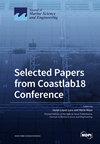Numerical Investigation of the Hydrodynamic Characteristics of a Novel Bucket-Shaped Permeable Breakwater Using OpenFOAM
IF 2.8
3区 地球科学
Q1 ENGINEERING, MARINE
引用次数: 0
Abstract
To align with contemporary concepts of low-carbon and environmental protection, a new type of bucket-shaped permeable breakwater, based on the prototype of the bucket-based breakwater in Xuwei Port Area, Lianyungang, Jiangsu Province, China, was proposed. A three-dimensional numerical wave flume was constructed using the OpenFOAM platform and DXFlow (an open-source computational fluid dynamics toolbox based on OpenFOAM). The effectiveness of this numerical wave flume was validated through temporal and spatial verification, wave generation validation, and model testing. The study investigated the effects of bucket porosity, opening shapes, number of openings, and the positioning of these openings on the wave-dissipating performance under regular wave conditions. It analyzed the force characteristics near the openings. The results showed that within the relative wavelength range of L/D between 6.7 and 12.7, relative wave height H/d between 0.175 and 0.275, changes in wavelength had a limited impact on the wave-dissipating performance of the bucket-shaped permeable breakwater. The wave-dissipating performance was primarily related to the porosity, with the optimal overall wave-dissipating performance occurring at a bucket porosity of 12%. The shape and number of openings had a minimal relationship with performance. Additionally, the connecting walls of this type of breakwater experienced the most significant wave impact, suggesting that these areas should be reinforced in practical engineering applications.使用 OpenFOAM 对新型斗形透水防波堤的水动力特性进行数值研究
为与当代低碳环保理念相适应,以中国江苏省连云港市徐圩港区的斗型防波堤为原型,提出了一种新型斗型透水防波堤。利用 OpenFOAM 平台和 DXFlow(基于 OpenFOAM 的开源计算流体力学工具箱)构建了三维数值波浪水槽。通过时空验证、波浪生成验证和模型测试,验证了该数值波浪水槽的有效性。研究调查了水槽的孔隙率、开口形状、开口数量以及开口位置对规则波浪条件下消波性能的影响。研究还分析了开口附近的力特性。结果表明,在相对波长 L/D 介于 6.7 和 12.7 之间,相对波高 H/d 介于 0.175 和 0.275 之间的范围内,波长的变化对桶形透水防波堤的消波性能影响有限。消波性能主要与孔隙率有关,当水桶孔隙率为 12% 时,整体消波性能最佳。开口的形状和数量与性能关系不大。此外,这种防波堤的连接墙受到的波浪冲击最大,这表明在实际工程应用中应该对这些区域进行加固。
本文章由计算机程序翻译,如有差异,请以英文原文为准。
求助全文
约1分钟内获得全文
求助全文
来源期刊

Journal of Marine Science and Engineering
Engineering-Ocean Engineering
CiteScore
4.40
自引率
20.70%
发文量
1640
审稿时长
18.09 days
期刊介绍:
Journal of Marine Science and Engineering (JMSE; ISSN 2077-1312) is an international, peer-reviewed open access journal which provides an advanced forum for studies related to marine science and engineering. It publishes reviews, research papers and communications. Our aim is to encourage scientists to publish their experimental and theoretical results in as much detail as possible. There is no restriction on the length of the papers. The full experimental details must be provided so that the results can be reproduced. Electronic files and software regarding the full details of the calculation or experimental procedure, if unable to be published in a normal way, can be deposited as supplementary electronic material.
 求助内容:
求助内容: 应助结果提醒方式:
应助结果提醒方式:


